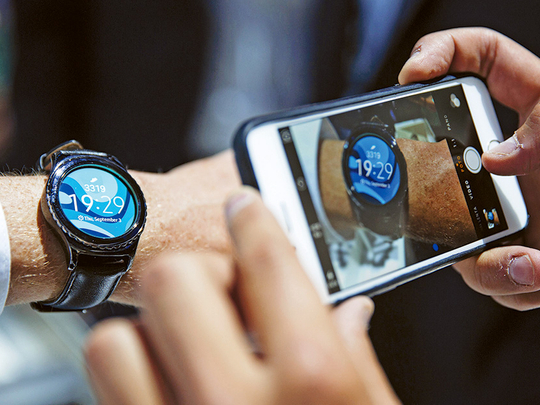
In November, Emirates NBD launched a novel service in the UAE banking market. The bank’s Fitness Account is a savings account that allows customers to earn higher rates of interest the more physical activity they do. Such initiatives are possible thanks to the development of smartwatches like the Apple Watch and Samsung Gear and wristbands like the Fitbit, all of which can keep track of the number of steps someone takes in a day or how far they run.
Globally, sales of smartwatches have yet to really take off. Juniper Research, a UK-based technology consultancy, says that 17.1 million smartwatches were shipped last year, with Apple accounting for just over half of the total. The rest of the market was dominated by cheaper devices with more basic functionality that are not well suited to the complexity of banking services.
Others put the sales figure higher. Gartner, another research firm, estimates that 30 million smartwatches were sold across the world last year, and it expects the number to rise to 50 million this year and 66.7 million in 2017. Even at these levels, however, the smartwatch is a long way from becoming a ubiquitous part of modern life. Other devices have fared even worse.
For example Google Glass, a high-tech headset designed to be worn like a pair of spectacles, was launched with great fanfare in 2013, but then was withdrawn from sale in 2015 after failing to capture the imagination of anyone beyond a small constituency of early adopters.
Not much traction?
The cautious attitude of consumers inevitably raises a question about how much demand there will be for banking services on devices like smartwatches and perhaps helps to explain the tentative approach of many banks.
According to a survey by Misys, a London-based software firm, only 15 per cent of banks around the world have a wearable app at the moment, although 52 per cent say they will have one in place over the next 18 months and 72 per cent say it is on their road map for the next three years. Banks in the UAE are no more keen than their peers elsewhere. “The potential for wearable technology in the banking space is yet to be realised in the UAE,” says Mosabah Al Qaizi, Head of Electronic Banking Services at Dubai Islamic Bank.
Of course, it is not simply a case of smartwatches. Other devices could start to become more prominent in the years ahead such as smart wristbands or rings and as technology improves so will their sophistication. At the moment though, the idea of wearable technology for banking services is still characterised more by future potential than current opportunity, and it makes sense for most banks to concentrate on improving their other digital services.
“Banks continue to face challenges with their digital strategies, so it is no surprise only a small percentage support wearables,” says Balazs Vinnai, General Manager of Digital Channels at Misys.
For now, most banks in the UAE are just keeping an eye on the segment, rather than jumping in to the market. The approach of National Bank of Abu Dhabi (NBAD) is typical of many. Suvrat Saigal, Managing Director and Head of Global Retail at NBAD, says it is “excited by the potential applications that could become available” and adds “we are closely monitoring this area”.
Pay with wearables?
Some banks are moving ahead with services, however. Mashreq’s latest version of its Snapp mobile app includes an Apple Watch component. The bank’s customers will be able to view balances for their current and savings accounts on their watch, as well as details of recent transactions, discount offers and ATM and branch locations.
There are other services that could yet boost the use of wearable technology, in particular using a watch or another device to make payments, perhaps by placing it up against a reader. The Misys survey found that two thirds of banks identified such proximity payments as the most attractive potential area for wearable apps.
“Early adopters have already started using wearable technology and we see there is huge scope for it to expand to payments,” says Aref Al Ramli, Head of Electronic Business and Innovation at Mashreq Bank. “That is the main potential for the future.”












